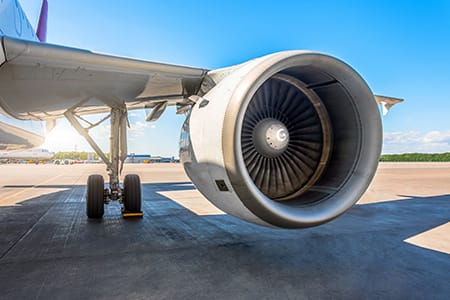
By George Koudis PhD, Product Manager at Cirium
Aircraft condensation trails, better known as contrails; are the line shaped clouds caused when hot humid air from an aircraft engine mixes with low pressure and low temperature air in the atmosphere. Over the last few years, researchers have increasingly highlighted the potentially significant impact that contrails will have on global warming. This article aims to answer some of the key questions around the environmental impact of contrails.
Why should the aviation industry care about contrails?
When most of us think about climate change, we think about CO2. This is fair for most industries, but not for aviation, where most operations occur directly in the troposphere and can therefore have a direct and immediate impact on global warming.
The latest research suggests that non-CO2 impacts comprise about two thirds of aviation’s overall climate impact. The biggest contribution of which is from contrails and contrail-induced cirrus, accounting for approximately 50% of aviation’s total warming effect.
It is estimated that just 2% of flights are responsible for 80% of the total climate impact of contrails, so there are potentially huge benefits to be achieved through a relatively small number of operational interventions.
Furthermore, the full climate impact of contrails happens in a short space of time (hours), whereas the impact of CO2 occurs over a long period of time (decades). Future carbon capture technologies may even mitigate the requirement to reduce CO2 emissions, but no such technology could mitigate the impact of contrails after they’ve already occurred.
Is there scientific proof around the impact of contrails on global warming?
Contrails contribute to global warming by absorbing and trapping solar radiation from the sun within the Earth’s atmosphere, where it would have otherwise travelled back into space.
There is agreement within the scientific community that these global warming impacts of contrails and contrail-induced cirrus are proven.
Some uncertainty still exists in our ability to predict the regions of the atmosphere where long-lived contrails are likely to form (short-lived contrails have a relatively small impact), and research is ongoing in this area.
When do contrails result in a net warming impact?
Research suggests that the most highly warming contrails happen at dawn and dusk and when aircraft are cruising at altitudes of between 35,000 and 41,000 ft.
Contrails produced throughout the middle of the day can have an overall cooling effect as they reflect sunlight back into space rather than trapping it at the Earth’s surface.
The newer commercial jet aircraft tend to cruise at higher altitudes than older types. Is this better or worse for contrail formation?
The likelihood of contrail formation for newer aircraft cruising at higher altitudes is potentially worse if it means that they are operating within the altitudes of 35,000 and 41,000 ft.
However, it is worth noting that contrails occur at relatively narrow altitude bands at any given time, and the location these bands is quite dynamic. Therefore, it would be unfair to assign an aircraft’s cruise altitude as the main driver for a specific flight to be more or less likely to produce contrails. This will primarily be driven by the meteorological forecast on the day.
Is there any difference in contrail formation between different engine types?
There is a difference in the likelihood of contrail formation for different engine types.

Contrail formation (or lack of) is well correlated to the ‘cleanness’ of the engine burn. Engines emit soot particles (particulate matter) which act as nucleation points for the water vapour (from the engine itself or ambient in the atmosphere) to condense on. Generally, more soot particles equate to more surfaces for the water vapour to condense on and increased likelihood of clouds to form.
An interesting area of research now surrounds the use of SAFs and hydrogen, both of which burn ‘cleaner’ but may produce more water vapour. The general consensus is that both lead to fewer contrails being produced, but research is ongoing.
In the UK, DEFRA recommends multiplying all CO2 emissions from air travel by a factor of 1.9 to represent the total global warming impact. Is this a realistic figure, based on the latest research?
For an individual flight, utilizing an average will not generate an accurate figure for global warming impact as there is a very broad range of climate impact that a flight can have due to contrails. This extends all the way from a net cooling effect to a warming effect equivalent to tens of times that of the CO2 of the same flight (remembering that 2% of flights lead to 80% of aviation’s contrail-induced warming).
However, the overall impact of contrails is roughly equivalent to the same as CO2 alone. So, if the requirement is to account for contrails over an extended period (e.g., one airline’s climate impact for the year) then a 1.9x factor may be suitable.
How can aviation analytics help flights to avoid producing warming contrails?
Data-driven aviation analytics is essential in mitigating aviation’s global warming impact due to contrails.
Firstly, analytics is required to benchmark operations, allowing stakeholders from across the aviation industry to accurately quantify their overall climate impact and identify areas for improvements. Secondly, analytics is required to allow aviation stakeholders to predict the regions where contrails are likely to form, and then make informed operational decisions to avoid these areas.
Contrail formation can be mitigated in the ‘planning’ phase by adjusting the flight plan prior to take-off to flying through regions where contrails are likely to form, and most operational trials conducted so far have used this method for contrail avoidance.
Alternatively, the flight route can be modified ‘tactically’ (i.e., during flight), with more up-to-date forecasts or even current conditions by providing this data to Air Traffic Control (ATC) or the pilots on the flight deck.
Both approaches require many different parties to come together including met/contrail forecasters, airlines, flight planners, ATC, and others. There are also trade-offs to consider when changing routes too including ANSP charges, additional fuel (although research suggests contrails can be avoided with negligible fuel impact), ATC constraints, and time to destination.
Despite these challenges, great opportunities exist to reduce aviation’s climate impact through contrail avoidance, and it is potentially much easier and quicker to accomplish than decarbonisation.
Learn how Cirium is empowering the global aviation industry to reach a more sustainable future with the most accurate aircraft emissions data.
























































